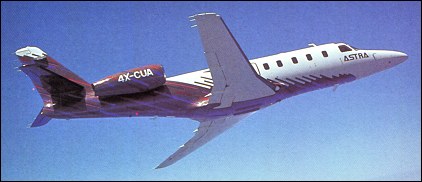| Ronald Solomon, e-mail, 22.04.2020 22:48 My name is Ron Solomon and very proud to see how far the Astra has come along over the last few decades. I had travelled several times to Los Angeles to work with Manufacturing houses and also oversee the Shot-peen forming of the dehydral wing skins at Metal Improvement in Vernon, California.I was in charge of the manufacturing, Jig design and build of the Wing Assembly and final build of the FIRST Astra Prototype Jet at Israel Aircraft Industries. I had a great Team. reply |
| Uncle Jim, e-mail, 27.01.2010 23:56 The IAI-1125 Astra is a comprehensively upgraded development of the successful IAI-1124 Westwind, with a number of key changes to improve performance and increase cabin volume. It is now part of the expanded Gulfstream stable, designated G100.
Israel Aircraft Industries began work on an improved development of its model 1124, initially known as the 1125 Westwind, in the early 1980s, with the first flight of the new type occurring on March 19 1984. A second prototype flew in October 1984, and a third was used for ground based static and fatigue testing. The first production Astra flew in March 1985, and the first customer delivery took place in mid 1986 after certification had been granted in August the previous year.
The Astra is based on the basic Westwind II fuselage and tail, mated with an all new high speed swept wing (initially lacking winglets). Aside from the aerodynamic and hence performance benefits of the new wing, it was also repositioned low on the fuselage (as opposed to mid mounted on the Westwind), where it does not intrude on internal cabin space. The repositioned wing plus reshaped fuselage frames means that headroom is increased by 20cm (8in). Other changes include a lengthened nose for greater avionics space and more extensive use of composites (mainly for control surfaces).
The original 1125 Astra was replaced in production by the Astra SP. The SP was first announced in 1989 and features a revised cabin interior, upgraded avionics, EFIS cockpit and some minor aerodynamic refinements. Thirty seven were built before it was replaced by the SPX.
The SPX, renamed G100 from September 2002, first flew in August 1994. It features more powerful FADEC equipped 18.9kN (4250lb) Honeywell TFE731-40R-200Gs, winglets and Collins Pro Line 4 avionics.
IAI builds the G100 in Israel and the "green" airframes are flown to Lincoln, Nebraska in the US for interior outfitting. Gulfstream acquired Galaxy Aerospace, which held the Astra type certificates and was responsible for marketing, in May 2001.
In September 2002 Gulfstream announced the improved G150, based on the G100 but with an enlarged fuselage and seating for six to eight. It will be powered by TFE731s, cruise at Mach 0.75 and have a range of 5000km (2700nm). Deliveries are due in 2005.
Two Astra SPXs have been delivered to the US Air Force (Air National Guard) as C-38As for transport and medevac tasks.
Copyright Airliners.net, some information Copyright Aerospace Publications reply |











